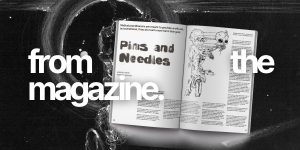LGBTQIA+ carers: Queer people providing unpaid care
By: Alex Creece

As queer people, we experience higher rates of disability than our non-queer counterparts. We also tend to care for others with disability and chronic health conditions. Often, this means that disabled LGBTQIA+ people are caring for each other – I can definitely relate!
We often show up for each other when we’re otherwise let down by traditional family structures and mainstream services. Sometimes we are caring for our exes. Sometimes it’s our relatives and lovers. Sometimes it’s our neighbours, or housemates, or partners of our ex-partners.
Sometimes it’s biological family with added complications. LGBTQIA+ people providing unpaid care face specific challenges, too.
Luckily, there are resources out there for unpaid carers. The first step is to identify whether you are a carer, and then to find out how to seek assistance.
Carer Gateway is an Australian Government program providing free services and support for carers. Rainbow Crew is run by Merri Health and Alfred Health as a part of Carer Gateway.
Carer Gateway is a proud supporter of Archer Magazine.
What is an unpaid carer?
According to Alfred Health Carer Services, an unpaid carer gives ongoing support to someone who:
- has a chronic or terminal illness
- has a disability
- has a mental health condition
- is frail or vulnerable due to their age.
Parents of children with disabilities – including adult children with disabilities – are also considered carers, depending on their circumstances.
Basically, anyone who provides unpaid care to a person is a carer.
LGBTQIA+ carers face specific barriers
I recently spoke to Nicholas Colicchia from Merri Health and Kylie Watt from Alfred Health Carer Services to understand the role of carers in the LGBTQIA+ community, and the supports available. Nicholas told me:
“We hear a lot of language [within the caring space] that doesn’t apply to LGBTQIA+ people – for example, the idea of ‘family’, which we want to redefine as ‘family of choice’, and language around being a ‘parent’.
“Caring for a friend is another good example – we don’t hear about this experience that often. Also, [being a carer] doesn’t always mean it’s someone you live with, are in a relationship with, or even someone you love. We hear language around ‘caring for a loved one’, but we speak to participants who don’t necessary love the person – it’s complicated, and life is messy at times.
“People may be caring for their exes, because we often keep in touch with those relationships in LGBTQIA+ communities. Occasionally, a person can still be stuck in a cycle of abuse with the person they’re providing care for.
“Another example is the poly community: a person may be caring for someone who is a partner but not your only partner, or a partner’s partner, or possibly multiple partners at once. Research [also] shows that 43.8% of carers themselves live with their own chronic health condition or disability, including mental health issues. When you look at the stats on top of that amid the queer community, you see the layers of complexities.”
Kylie added: “In the rainbow community, autism [may also be] more prevalent, so autistic parents are often caring for autistic children, and vice versa.”
What is a hidden carer?
Despite the high portion of carers in the LGBTQIA+ community, many of us don’t self-identify as such – we are ‘hidden carers’. This means that we often lack support in our caring roles, and miss out on opportunities for connection and assistance.
These barriers are compounded by other intersections of marginalisation – such as age, race, cultural background, disability, and more – which prevent hidden carers from seeking and accessing support.
Nicholas said: “Shame is a component [in identifying as a carer], which correlates with stigma. There are also many multicultural and ethnic groups in which reaching out for support is taboo.”
Kylie agreed: “[If you’re queer and] culturally and linguistically diverse, that’s another layer of complexity. This makes these cohorts really hard to [reach] and support.”
In the LGBTQIA+ community, many young people are likely to take up caring roles within their social circles.
Kylie said: “It’s hard enough as an adult to get your head around caring for someone, let alone if you’re a child who’s always been responsible for doing a lot of things a parent would usually do. You don’t necessarily see yourself as different, or if you do, you don’t necessarily want people to see that you’re different, so it can become a bit of secret.”
What supports can I access as an LGBTQIA+ carer?
If you’re an unpaid carer, there might be more resources available than you realise.
Nicholas and Kylie informed me about the Carer Gateway, a federally funded initiative that provides short-term, intervention-based supports for unpaid carers living in so-called Australia.
“Through Carer Gateway, you can access counselling, coaching, and even material supports such as a computer or other equipment if it will help you in your caring role,” Kylie said. “You can get respite workers to help you look after the care recipient so you can go get the groceries. You can access food services.
“All of our services are free – we are not means tested. It doesn’t matter what other payments you’re getting, you can get support from Carer Gateway.
“This is a short-term service, as the Gateway is mostly focused on capacity building for the care providers, rather than long-term support.”
What is peer support?
Through Carer Gateway, you can also access peer support groups to connect with other people in the caring space who share similar experiences.
Nicholas and Kylie are facilitators of the Rainbow Crew, which provides peer support for carers within the LGBTQIA+ community. According to Nicholas:
“The Rainbow Crew is the true definition of what the framework of peer support is designed for: making people feel less alone in the world, more seen and heard, more connected, and this creates a less isolating experience which can be helpful for mental health outcomes, and wellbeing in general.
“I think this peer support group is extremely unique. It brings people together and focuses on the intersection of LGBTQIA+ community and caring in a way that hasn’t been done before in the carer space.
“[It shows rainbow carers] that they’re not alone, and that there are other people within our communities that may have been through similar experiences. It also breaks down the traditional heteronormative walls that can exist in the caring space.”
“It’s been an amazingly successful group,” Kylie agreed. “It’s what fills my bucket every day at work. It would be nice to see it replicated throughout other states, and countries across the world.”
How does peer support help LGBTQIA+ carers?
Peer support – especially in groups specifically for LGBTQIA+ carers – can be a huge source of connection and solidarity. I spoke to two carers from the Rainbow Crew peer support group about their experiences.
Finn’s story
Finn*, a participant in the Rainbow Crew, shared some of their caring journey with us:
“I was working full time when me, my young son and my wife all got COVID. My wife, who was otherwise fit and healthy, needed to be hospitalised with respiratory issues [due to COVID]. She developed severe long COVID, and extreme fatigue to the point where basically she couldn’t get out of bed.
“It’s a weird shift to suddenly become a carer to your partner, and it was really good to have space to talk about that dynamic.
“While there are advantages of having [a general] support group, what’s critical is having a queer support group. I identify as a trans man. In the Rainbow Crew, there was an ease with which I could talk about transitioning and starting T and sexuality and gender in amongst everything – like, the discussions aren’t just limited to being in a caring role.
“You can talk about your whole life experiences, and that includes your queerness. I don’t think I’d have had the same experience in another support group.”
Emily’s story
Emily* originally joined the Rainbow Young Carers group before connecting with the Rainbow Crew:
“[My partner and I] were only 21 when then they got sick – really sick. We didn’t have answers, and things didn’t work out in terms of care from their family of origin, and so it became a sort of necessity that I had to move in and look after them.
“It took well over a year for a diagnosis, and a long time to get any kind of financial support from Centrelink. It was even difficult to find doctors that were willing to take on the case. And in the meantime, my partner was getting sicker and sicker and sicker.
“We still don’t have all the support we need – my partner still isn’t on the National Disability Insurance Scheme (NDIS) and Disability Support Pension (DSP). I had to lean on whatever I could, and I sought out all the support groups. I needed somewhere to unload [my emotions].
“Initially, I had joined the Rainbow Young Carers group, but I found that that the Rainbow Crew was a better match for me. Young carers are usually defined as carers up to the age of 25, but I noticed it was more early teenagers caring for parents and siblings, rather than [a young adult] caring for a partner.
“I now go to a few different support groups, and they all provide something different. The Rainbow Crew is my opportunity to connect with a community that I have otherwise lost. Being able to talk frankly about financial strain, difficulties with family of origin, and the impact of disability on intimacy with other adults is really helpful.
“I’m home all the time, as my partner requires almost 24/7 care. So, I don’t go to Pride events. We have to be very COVID-conscious. We lost a lot of friends, too.
“Peer support is the only way I can stay connected to the LGBTQIA+ community. And having [virtual sessions] has been crucial – there’s no way I could access this group if it was an in-person thing.
“My partner and I have faced a lot of intersectional social, medical and financial challenges due to our age, gender and sexuality. For me, it was important to find support groups where that intersectionality was understood.”
How to access carer support
Speaking to carers and service providers made me realise that most people I know are rainbow carers and/or care recipients – myself included. As a disabled queer, care is a vital part of my daily life, but I still wasn’t fully aware of all the things that it encompasses.
Many of us are well-versed in navigating arduous, bureaucratic systems – like Centrelink and the NDIS – but community-based supports and resource hubs like Carer Gateway remain lesser-known.
Our caring roles shouldn’t go unnoticed and unsupported. By identifying as a carer, care recipient, or both, we become more visible in these spaces as LGBTQIA+ people. There are lots of us out here – let’s find more ways to sustainably care for ourselves and our community.
Carer Gateway is an Australian Government program providing free services and support for carers. Rainbow Crew is run by Merri Health and Alfred Health as a part of Carer Gateway.
Carer Gateway is a proud supporter of Archer Magazine.
*Names changed for privacy













